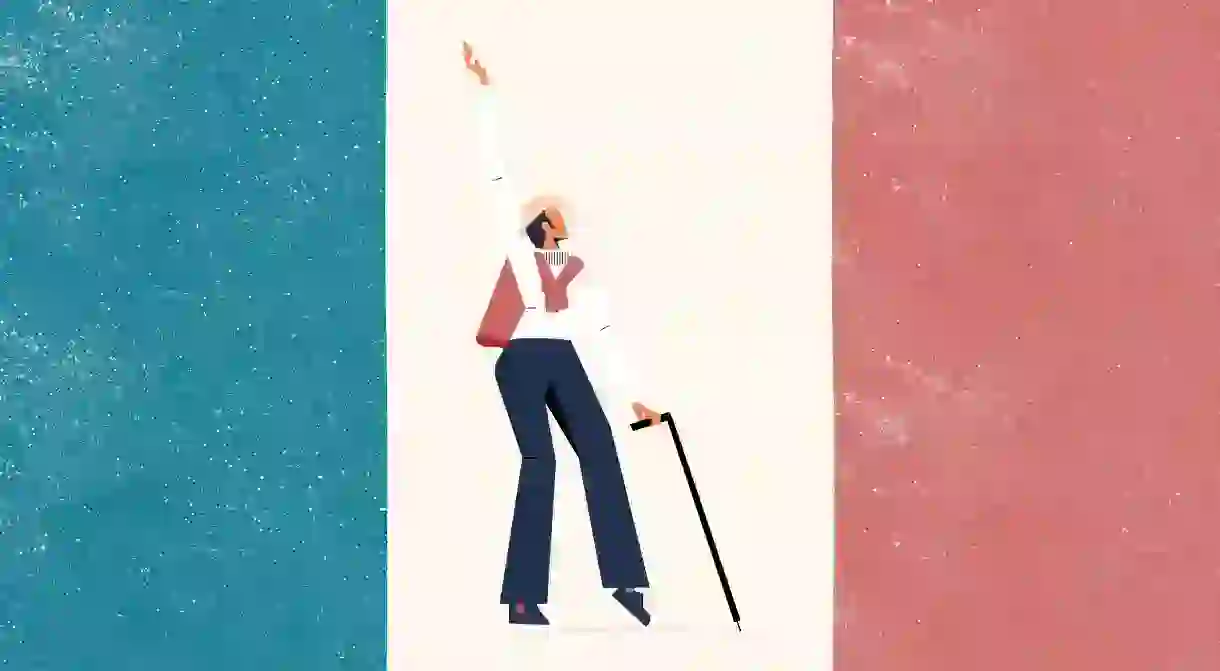Some 50 Years Later, the Battle of Versailles Rivalry Remains

American designers may have spurned New York Fashion week for Paris during the SS18 season, but the tension between two great sartorial powers has been going on for a lot longer.
What do you do when the palace needs renovating and there’s not enough in the bank? Simple: host a fashion-off between 10 of the best designers in America and France, and bring everyone in the industry to watch. Such was the decadent thought process of publicist Eleanor Lambert, who organised the now infamous Battle of Versailles in 1973 to help raise funds needed to restore Louis XIV’s palace.
The event, which brought together the heavyweights of French couture (Christian Dior, Yves Saint Laurent, Pierre Cardin, Emanuel Ungaro and Givenchy) to compete with five emerging American designers – Anne Klein, Stephen Burrows, Bill Blass, Oscar de la Renta and Halston. Against the pomposity of traditional couture, the Americans slung the raw energy of a Liza Minnelli performance, a captivating routine from Billie Blair and offered a radical new agenda through the inclusion of 11 African American models: it was a sartorial showdown like no other, and catapulted American designers to heady new – and international – heights.
As a moment of fashion history, it set a fascinating precedent for disruption and innovation in the industry, at a time of great instability. As Dr Valerie Steele notes in her book Paris Fashion: A Cultural History, ‘The spread of the hippies’ anti-fashion sentiment, together with the rise of feminism, led many people to reject the imposition of any fashion authority.’ As such, it was an era which proved ripe for new design blood to offer something new, which moved away from convention and put the power in experimentation and change.
As such, The Battle of Versailles also proved a pivotal moment in demoting the prowess of Paris to one in a handful of major cities: couture was no longer king.
If the Battle of Versailles demonstrated the punching power of the new guard from across the Atlantic, it seems that some 50 years later the power balance has slipped firmly back in favour of the old masters (of course, there’s been much slipping and sliding in between).
New York Fashion Week SS18 certainly suffered from a lack of attention this season, as now heavyweight American designers such as Thom Browne, Off-White, Rodarte, Proenza Schouler and Altuzarra moved their shows to Paris. While designers had different reasons for leaving, the political landscape undoubtedly played a part. Meanwhile thanks to the historical allure of the city, some American designers, such as Rick Owens, have been showing in Paris for years.
A post shared by RODARTE (@rodarte) on Sep 26, 2017 at 6:33pm PDT
That said, American designers in Paris certainly brought something new, and typically ‘American’ for the SS18 shows.
SS18 Rodarte included cowboy boots, low-slung western looks in the form of leather slacks and frilled, bias cut dresses that evoked a romantic cowgirl. The vibe drew from traditional American tropes and imbued them with Parisian glamour – a theme that was also reflected at the Altuzarra SS18, where a subtle Western theme pervaded courtesy of fringe detail, paisley prints and specks of cow hide.
Thom Browne took a different tack, offering fantastical and theatrical scenes which began with a unicorn parading down the catwalk and finished with foaming, bubble gum coloured costumes which merged brocade silk jackets, wool finishes, layers of chiffon and corporate ties. The result was to immerse the audience fully in a dream world, far removed from the daily sludge. Rick Owens offered a little more dystopia than fantasy, with a theatrical set in Palais de Tokyo that saw the front row sporting custom waterproofs.
A post shared by Thom Browne (@thombrowneny) on Oct 3, 2017 at 4:17pm PDT
If the Americans imported playful commentary on their national identity, some 50 years on from the ready to wear explosion it was clear that the French houses have not only adapted, but accelerated their game to spectacles which trump even Donald.
Chanel’s waterfall at Palais Royal was one obvious example. The show, which brought hordes of spectators, people watchers and traffic to a crippling swell outside in the hours before, saw Lagerfeld create an über Instagram-friendly waterfall, with waterproof accessories to match. The spectacle followed on from previous highlights that have seen the house create rockets, the Eiffel Tower, and iconic Greek sites – to name a few.
At Yves Saint Laurent, in an open-air show which took place just weeks after Yves’ long-time partner Pierre Bergé died, the brand kick-started the week by lighting up the Eiffel Tower and presenting statement clothing to match. Meanwhile Agnes B kept things simple while still flexing the French sartorial prowess: champagne and canapés were served to guests before being seated on refined, plump chairs to watch a confident collection in serene, understated surroundings.
Against a wider political context, it seemed American designers were wrestling with a tension between exporting the American dream, and accepting that the country which bore that dream is no longer the promised land. Conversely, French designers, riding perhaps on the energy of Macron’s victory, seemed comfortable and confident in their aesthetic and capacity to deliver the best in the industry.
But fashion is an uncertain world, and the US is ripe to stage a comeback. Perhaps both nations will be dethroned by the new talent from eastern Europe, or perhaps Korea will expand its reach on the international stage. The sartorial victor will be the one that innovates the fastest, and given the turbulent times we live, that’s one trend we can’t forecast.













